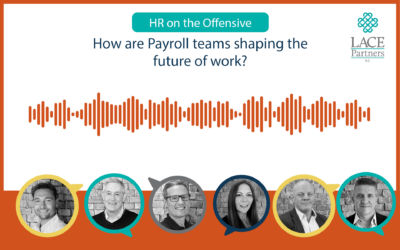How do you choose the right skills solution for your business?
So far, in our Becoming skills-powered campaign we’ve mapped out the foundations of what a skills-based organisation is, as well as shown you a ‘quick start’ framework for building your approach. We’ve also had some friends talk to us about their experiences from a vendor perspective from our friends at Gloat, as well as a practitioner with Craige from Pandora on his thoughts on how to build a skills strategy to boost business success.
Today, we will be discussing how to choose the right skills solution, according to your business context and goals.
The business drivers
From a LACE perspective, before you make the decision on the ‘what’ you are going to build in your approach to skills, you need to consider the ‘why’ and then the ‘how’.
We believe in aligning your HR and talent initiatives cleanly with your business goals. Whether you are picking the right skills strategy or building an HR operating model – our advice is the same: Determine what your main business driver is and build your solution to support it.
What are the key business drivers?
Agility
The business is constantly reshaping the business landscape and / or respond with rapidly evolving competitor landscape
Customer intimacy
You have a frontline workforce who interact directly with the customer
Productivity
If your business is heavily focused on reducing its cost base and maintaining increased margins
Rapid growth
A start up aiming for rapid expansion or an established business who is private-equity-backed and undergoing rapid growth
Every organisation is different and has differing layers of complexity. It is true that your business can have multiple drivers but by pinpointing your primary driver(s), you can identify the specific skill sets most critical to achieving them. If you have more than one driver, you may need more than one solution or you may need to prioritise.
Agility
POTENTIAL CHALLENGES
-
Skills unavailable to meet demand
-
New skills needed to support new / acquired business ventures
SKILLS SOLUTIONS
- Work design
- Talent mobility
- Skills-based reward
SUCCESS METRICS
- Percentage of internal hires/cross functional moves
- Increased mobility
- Responsiveness to change
- Increased speed to market for new products / services
- Revenue and profitability of new business ventures linked to skill mobilisation / agility
Customer intimacy
POTENTIAL CHALLENGES
- Attracting and retaining customer experience skills
SKILLS SOLUTIONS
- Skills-based learning
- Skills-based hiring
- Talent mobility
SUCCESS METRICS
- Increased customer retention OR reduced customer churn
- Increased retention of CX skills
- Increased diversity (customer diversity / workforce reflective of customer base)
- Increased employee retention
- Increased engagement
- Increased mobility
- Improved Net Promoter Score
- Increased Customer Lifetime Value growth
Productivity
POTENTIAL CHALLENGES
- Talent attraction and retention for high demand skills
- Opportunity to use tech/AI to automate and improve efficiency
- Upskilling employees whilst maintaining productivity targets
- Need for multi-skilling to enable flexible resource deployment
SKILLS SOLUTIONS
- Work-design
- Talent mobility
- Skills-based learning
SUCCESS METRICS
- Increased output (£, activities executed on, products produced, sales)
- Increased employee retention
- Increased mobility
- Increased revenue per FTE (indicates skills being deployed effectively)
- Increased innovation rates (the number of new products / solutions developed)
Rapid growth
Skills solutions can power business growth by ensuring you have the right skills in the right place at the right time.
POTENTIAL CHALLENGES
-
Skills unavailable to meet demand
-
Attraction of specific skill
SKILLS SOLUTIONS
- Skills-based workforce planning
- Skills-based hiring
- Skills-based learning
SUCCESS METRICS
- Reduced time to hire
- Reduced cost to hire
- Increased employee retention
- Increased engagement
- Increased speed to market for new products / services
- Business expansion into new markets / geographies enabled by skills strategy
Learn about our skills solutions:
We cover these briefly in our quick-start skills guide, but explore below to learn more about what the key skills solutions look like and where to get started with them.
Sign up for the skills campaign to get new chapters as we release them; future chapters include looking at skills solutions through an employee experience lens.
don't touch or delete
Skills-based workforce planning
An approach to workforce planning that forecasts the skills required to meet desired business outcomes. It focuses on the skills required rather than the existing or pre-defined job roles. Skills-based workforce planning allows you to understand your workforce as the sum of its parts – analysing the current skills, where they can be deployed and what future skills are required.
Where to start:
- Building a skills taxonomy or common language for skills
- Map out the skills of your workforce using AI and/or self-service mapping/assessment
- Enhance your skills taxonomy with skills adjacency maps
- Predictive skills gap analysis
- Create skill profiles for key business areas and prioritise gaps and in demand skills
- Implement skills utilisation tracking using HR system and WFM tools
Organisations that have implemented these types of solutions are able to:
- Articulate the workforce’s current skills, the future skills needed (medium/long term) and the skills gap
- Implement learning and development plans to re-skill/upskill their workforce to meet both future skills demands and CSR/legal requirements
- Have high quality data, data analysis, performance and productivity metrics
Skills-based hiring
This describes the shift towards sourcing your internal and external talent based on skills rather than previous job titles, experience, or formal educational attainment. This approach broadens your potential talent pool and emphasises assessing potential.
Where to start:
- Determine the breadth of your skills-based hiring approach – consider starting with a particular skill or function that has high demand or scarcity
- Ensure your ‘job ads’ or talent marketing matches what work is required (see Work design below)
- Consider skills-based profiles for work packages / projects / gigs
- Remember to emphasise skill development and skills benefits to attract candidates
- Redesign your selection process; including screening, skills mapping, interviews and assessments
- Leverage existing technology/ATS with skills capability or consider integrating skills assessment platforms
- Upskill and enable your hiring managers through training, robust feedback frameworks and skill validation checklists
Organisations that have implemented these types of solutions are able to:
- Be more targeted in their talent search for skills
- Increase the talent pool through skill mapping and adjacency
- Provide a more diverse talent pool
- Improve quality of talent pipeline
- Improve efficiency and time to hire
Work-design
Work-design is a dynamic approach that requires organising roles and responsibilities by skills and competencies required to perform the work, including where technology can reduce workload. This means that capacity can be re-focused into re/upskilling or even other project-based work.
Where to start:
- Identify key skills required for each function e.g., technical and soft skills
- Create a skills map of your organisation that outlines the capabilities available across the workforce
- Visualise current skill gaps and overlaps
- Redefine job roles to align with skills rather than traditional roles
- Prioritise skill-based development over general training
- Shift hiring practices to focus on skills and potential rather than just educational qualifications or past job titles
Organisations that have implemented these types of solutions are able to:
- Improve employee engagement by recognising and developing their individual skillset
- Enable autonomous learning and career progression
- Leverage skills across different projects and departments
- Utilise the skills of their workforce more effectively by avoiding overstaffing or external resourcing
- Encourage continuous learning, ensuring that employees develop future-relevant skills
- Bring diverse skills together, fostering innovation through varied perspectives and expertise
Talent mobility
Ultimate talent mobility allows people with the relevant skills to move around the organisation to where they are needed both to deliver the work and continue to build their own skills. This can look different in each organisation – for example having one day a week on a new project can build skills and experience, or you may have employees undertaking short to long term projects sequentially.
Where to start:
- Create skill-based roles and pathways, allowing employees move to new projects or roles
- Leverage skills tools and/or internal communication to ensure resource can be matched to work
- Equip managers to have meaningful discussions with employees about skills-based career development
- Coach leadership and line managers through the mindset shift of sharing talent
- Work on embedding a culture of continuous learning, building skill building into daily work
- Refine your approach and pathways over time based on employee feedback and mobility effectiveness
- Celebrate successes and incentivise employees and managers who actively engage in talent mobility
Organisations that have implemented these types of solutions are able to:
- Quickly align workforce skills with evolving business needs
- Improve employee engagement and retention through meaningful growth opportunities
- Optimise talent utilisation by placing the right skills in the right roles at the right time
- Enhance organisation agility and responsiveness in a dynamic market
- Strengthen collaboration and knowledge-sharing across teams
- Use data to predict and manage skills demand and workforce trends
Skills-focused learning
Individualised approach to employee learning that prioritises practical, applicable skills over general knowledge, leading to more targeted and effective learning. Done right, it can produce tangible benefits for both employees and their organisations.
Where to start:
- Create personalised learning plans based on individual skills gaps, strengths, and career aspirations
- Prioritise engaging practical training methods such as industry-specific case studies, current projects, AI simulations and mentorship opportunities
- Incorporate core skills and behavioral competencies as well as technical skills
- Encourage an environment where ongoing skill development is valued and supported
- Offer cross-functional projects, skill-based task forces, or shadowing opportunities to allow employees to actively use their training
Organisations that have implemented these types of solutions are able to:
- Create environments where employees feel supported in their professional growth, boosting job satisfaction and retention
- Reduce skill gaps faster by targeting individualised learning paths, and boost cross-functional skills and understanding
- Increase productivity by developing employee skills that directly impact their performance, leading to more efficient and effective work
- Stay agile and innovative for industry shifts as skills-based learning keeps the workforce flexible
Skills-based reward
Incentivising the acquisition of new skills (or using them) through recognition or monetary reward. This can be further enhanced by embedding skill building to be recognised in the performance management cycle.
Where to start:
- Design a rewards structure that recognises skill acquisition through monetary bonuses, additional benefits, additional career opportunities or public recognition
- Create a performance framework where employees are set specific skill-based goals and receive feedback
- Develop a competency framework that reflects the skills needed at each level
- Ensure employees have the resources and support they need to develop new skills
- Partner with training providers, offer internal workshops and/or create an online learning library
- Develop a system within the HR portal or an internal communications platform where skill achievements can be shared
Organisations that have implemented these types of solutions are able to:
- Align employee development with strategic goals, improving performance outcomes
- Motivate employees to continuously upskill and build relevant competencies
- Increase employee engagement and satisfaction by recognising skill growth
- Enhance transparency around growth opportunities with clear skill milestones and rewards
Let us know if you found this useful, and also reach out with your questions via the form below.






